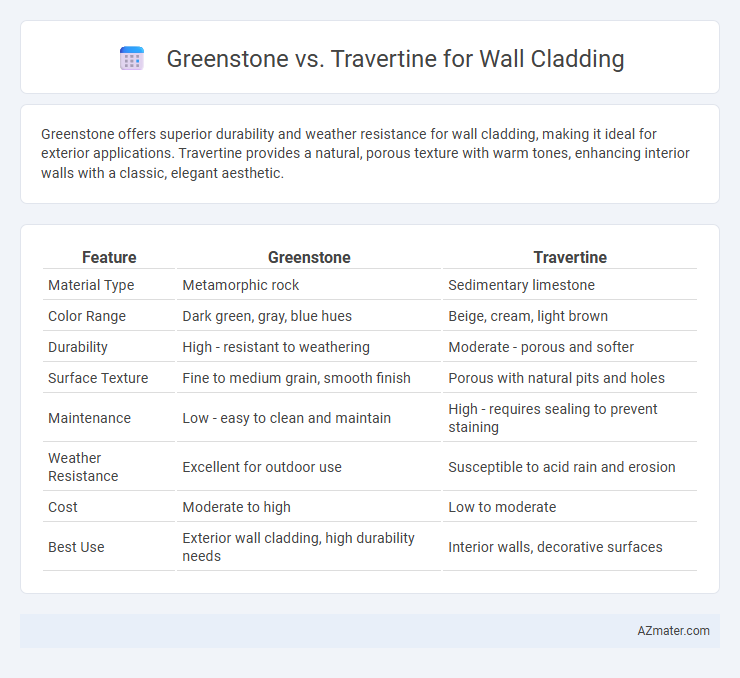Greenstone offers superior durability and weather resistance for wall cladding, making it ideal for exterior applications. Travertine provides a natural, porous texture with warm tones, enhancing interior walls with a classic, elegant aesthetic.
Table of Comparison
| Feature | Greenstone | Travertine |
|---|---|---|
| Material Type | Metamorphic rock | Sedimentary limestone |
| Color Range | Dark green, gray, blue hues | Beige, cream, light brown |
| Durability | High - resistant to weathering | Moderate - porous and softer |
| Surface Texture | Fine to medium grain, smooth finish | Porous with natural pits and holes |
| Maintenance | Low - easy to clean and maintain | High - requires sealing to prevent staining |
| Weather Resistance | Excellent for outdoor use | Susceptible to acid rain and erosion |
| Cost | Moderate to high | Low to moderate |
| Best Use | Exterior wall cladding, high durability needs | Interior walls, decorative surfaces |
Introduction: Greenstone vs Travertine for Wall Cladding
Greenstone and travertine are popular natural stones used for wall cladding, each offering unique aesthetic and durability benefits. Greenstone provides a dense, hard surface with a rich green hue, ideal for creating a modern, elegant look. Travertine features a porous texture and warm earth tones, delivering a classic, rustic appearance suitable for both interior and exterior applications.
Key Characteristics of Greenstone
Greenstone for wall cladding is prized for its exceptional durability, dense composition, and natural resistance to weathering, making it ideal for both interior and exterior applications. Its deep green hues and subtle, varied textures provide a unique aesthetic that contrasts sharply with the lighter, porous appearance of travertine. Greenstone's low porosity and strength contribute to superior longevity and minimal maintenance compared to travertine, which is more susceptible to staining and erosion.
Defining Features of Travertine
Travertine, a form of limestone formed by mineral springs, is characterized by its porous texture and natural saddle-like holes, which often create a unique, rustic appearance in wall cladding applications. It typically showcases warm, neutral tones such as beige, cream, and light brown, making it versatile for both interior and exterior surfaces. Compared to Greenstone, travertine's softer composition requires sealing for durability but offers distinct aesthetic appeal through its natural veining and subtle color variations.
Aesthetic Appeal and Visual Impact
Greenstone offers a rich, earthy palette with deep greens and textured surfaces that create a striking, natural aesthetic for wall cladding, enhancing spaces with a bold and organic visual impact. Travertine provides a classic, warm appeal through its soft beige tones and unique porous patterns, delivering a timeless elegance and subtle sophistication in interior and exterior applications. The choice between greenstone and travertine depends on whether a dramatic, rugged look or a refined, understated beauty is desired for the wall design.
Durability and Longevity Comparison
Greenstone exhibits exceptional durability against weathering and wear, making it ideal for long-term wall cladding applications. Travertine, while aesthetically appealing with its natural porous texture, requires sealing to enhance resistance to moisture and erosion over time. The inherent toughness and low maintenance of Greenstone contribute to a longer lifespan compared to the more delicate and porous nature of Travertine.
Maintenance and Cleaning Requirements
Greenstone offers low maintenance and cleaning requirements due to its dense, non-porous surface, which resists stains and moisture effectively. Travertine, with its porous texture, demands regular sealing and more frequent cleaning to prevent dirt absorption and surface damage. Choosing Greenstone for wall cladding minimizes upkeep costs and labor compared to the intensive maintenance routine required by Travertine.
Cost Analysis: Greenstone vs Travertine
Greenstone wall cladding generally offers a more cost-effective solution compared to travertine, with prices ranging from $8 to $15 per square foot, while travertine typically costs between $15 to $30 per square foot. The lower price of greenstone is attributed to its abundant availability and simpler extraction process, whereas travertine's cost reflects its unique porous texture and labor-intensive quarrying. Installation expenses for travertine may also be higher due to its delicate nature requiring specialized handling, impacting the overall budget for projects prioritizing cost-efficiency.
Environmental and Sustainability Factors
Greenstone offers superior environmental benefits for wall cladding due to its natural durability and low processing requirements, resulting in a smaller carbon footprint compared to travertine. Travertine, while aesthetically pleasing, undergoes more intensive quarrying and treatment processes, increasing its environmental impact. Choosing greenstone supports sustainable building practices through reduced resource consumption and enhanced recyclability in construction projects.
Best Applications and Design Styles
Greenstone offers a rich, earthy palette ideal for rustic and naturalistic wall cladding, enhancing outdoor spaces and accent walls with its durable, textured surface. Travertine's smooth, matte finish suits Mediterranean and contemporary interiors, elevating bathrooms and living rooms with its timeless elegance and light-reflective qualities. Both stones provide versatile applications, with greenstone excelling in rugged, high-traffic areas and travertine favored for sophisticated, warm, and inviting design styles.
Conclusion: Choosing the Right Stone for Wall Cladding
Greenstone offers superior durability and resistance to weathering, making it ideal for exterior wall cladding in harsh environments. Travertine provides a luxurious appearance with its unique natural patterns, best suited for interior or accent walls where aesthetics are a priority. Selecting between Greenstone and Travertine depends on balancing factors like durability, environmental exposure, and design preferences for optimal wall cladding performance.

Infographic: Greenstone vs Travertine for Wall Cladding
 azmater.com
azmater.com